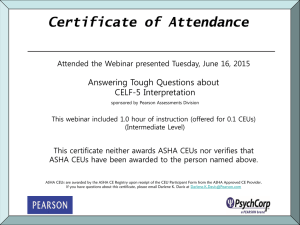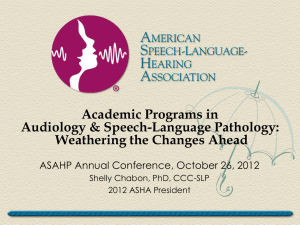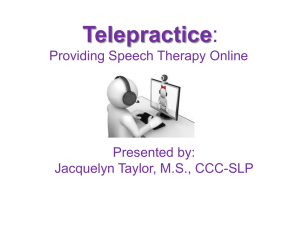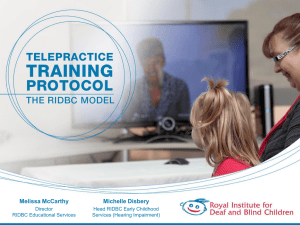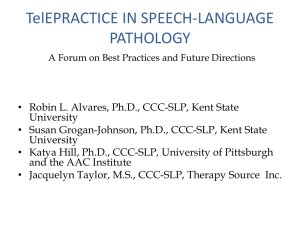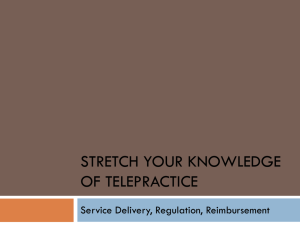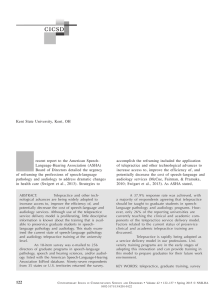Technology - Montana Speech-Language and Hearing Association
advertisement
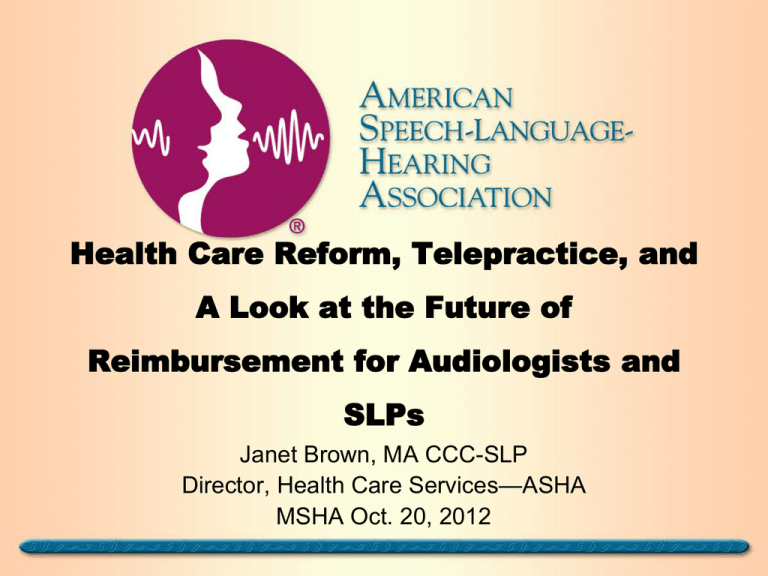
Health Care Reform, Telepractice, and A Look at the Future of Reimbursement for Audiologists and SLPs Janet Brown, MA CCC-SLP Director, Health Care Services—ASHA MSHA Oct. 20, 2012 Speaker Disclosure Financial • ASHA employee since 1997 Non-financial • Ex officio for Business Practices,Telepractice Committees • Member, American Telemedicine Association • “America’s health care is essentially a cottage industry of fragmented, dedicated artisans who eschew standardization. Care is frequently highly variable, and performance is, in large part, unmeasured.” Swenson, et al., 2012.The Mayo Clinic value creation system. AJMQ 27 (1), 5865. What is the Problem? • Health care spending has doubled as share of GDP in 30 years 9.2 to 17.9 • Medicare population will grow by 1/3 in the next 10 years • Variation in spending by region without evidence of difference in outcomes Source: MedPAC report, March 2012: Executive Summary Problems with Current System • Fee-for-service creates incentives for unnecessary care • Variability in payment across settings • Fragmented care (ex:VFSS) • No penalties for bad outcomes (e.g., rehospitalization) Components of the Patient Protection and Affordable Care Act (2010-2014) Expanded Coverage • Dependents • Medicaid eligibility • Exchanges (Iowa Affordable Insurance Exchange) • Individual mandate Payment • Bundled • Incentives for quality Adapted from Fabius, et al. 2012. Vocabulary of Health Care Reform. Thomson Reuters Care Coordination • Medical homes • Accountable care organizations Delivery Innovations • EHR • Meaningful use • Disease management Essential Health Benefits—Medicaid and Exchanges • 10 categories that must be included Ambulatory patient services Prescription Drugs Emergency Services Rehabilitative and Habilitative Services and Devices Hospitalization Laboratory Services Maternity and Newborn Care Preventive and Wellness Services and Chronic Disease Management Mental Health and Substance Use Disorder Services Pediatric Services, Including Oral and Vision Care SLPs and Pediatric Services • % of SLPs in health care providing services 17% to infants and toddlers 13% to preschoolers 11% to school-age children • 27% provide Early Intervention services • 20% of SLP caseload in autism up considerably from 6% in 2009 Source: 2011 ASHA SLP Health Care Survey Medicare • Medicare Part A—hospitals, SNFs May join ACOs Bundled care • Medicare Part B—outpatient Alternative to therapy caps— Documentation of outcomes Bundled care, ACOs Episodic payment? The New Order in Health Care— Public and Private Pay •Value Transition to Measures • Accountability through programs involving measures • Quality reporting systems affect reimbursement Under Medicare • Hospital value-based purchasing • Physician Quality Reporting System Outcome Measures • National Outcomes Measurement System (NOMS) developed by ASHA Data collection system that illustrates the value of SLP services Uses Functional Communication Measures (FCMs), a series of disorder-specific, sevenpoint rating scales to describe the change in an individual's functional communication and/or swallowing ability over time ASHA NOMS • SLPs register to become a NOMS user (free) • Submit FCM scores at admission and discharge • • • (online database) Submit data on diagnosis, tx frequency, etc. Receive standard reports and national benchmarking data More information at http://www.asha.org/members/research/noms/ NOMS • In 2008, eight of the 15 adult FCMs were endorsed by the National Quality Forum (NQF) as quality measures • NOMS can be used as an objective measurement tool for home health reassessments or Part B documentation How Will Life Change • Billing for services Fee for service to episode of care Bundling/ACO • Documentation systems EMR ICD 10 • Documentation/Justification of services Value/outcomes Medical Necessity What We May See More Of • Different levels of care within episode Support personnel Community Family/caregivers • Use of technology Telepractice/videoconferencing Technology apps/tools for independent practice What You Can Do • Look at your practice How can you be more efficient? • Process, documentation, practice How do you measure your outcomes? Are you diversified? What are your competitors doing? Reach out to potential referral sources, ACOs What You Can Do Be informed ASHA Leader ASHA web site: Health care reform page ASHA Healthcare Landscape Summit recommendations What You Can Do • ADVOCATE! Respond to Take Action—ASHA Grassroots network Contact your representatives at home Capitol Hill visits Role of Telepractice in Health Care • Increasing access to providers to specialists to equipment • Savings costs travel Complications from delayed treatment Role of Telepractice in Schools • Respond to shortages • Efficiencies in reducing driving time ASHA’s Definition • Telepractice is the application of telecommunications technology at a distance by linking clinician to client, or clinician to clinician for assessment, intervention, and/or consultation. ASHA, 2005 Speech-Language Pathologists Providing Clinical Services via Telepractice: Position Statement Terminology Makes a Difference • Using telepractice as a means of direct service delivery Telespeech, telehealth, telemedicine, telerehab, teletherapy Typically via teleconferencing (“face-to-face,” but not “in person” • NOT distance education • NOT distance supervision Why This Can Be Confusing • Telepractice: students delivering services via teleconferencing with supervisor sitting with them • Telesupervision: Clinical Fellow delivering services face-to-face with supervisor observing via teleconferencing And In Education… • Distance learning may incorporate interactive videoconferencing, virtual classrooms • May be used to teach SLPs • Not used to describe SLP services Quality Qualifier 2005 Position Statement • "The use of telepractice does not remove any • existing responsibilities in delivering services, including adherence to the Code of Ethics, Scope of Practice, state and federal laws (e.g., licensure, HIPAA, etc.), and ASHA policy documents on professional practices." “Therefore, the quality of services delivered via telepractice must be consistent with the quality of services delivered face-to-face." Position Statement, 2005 Challenges of Developing “Standards” • Rapid advance of technology • Lack of comparative effectiveness research on different types of technology • Scope of the professions: broad range in age disorders assessment and treatment procedures Quality Components • Provider competence • Patient selection • Technology selection • Transmission quality • Efficiency, effectiveness of service • Patient, caregiver, provider satisfaction ASHA’s Telepractice Resources • www.asha.org/teleprac tice Video clip Policy documents Articles Model licensure regulations Reimbursement information Bibliography Types of Telehealth • Synchronous (real time) • Asynchronous (store and forward) • Self-monitoring (not typically used in SLP) Technology Is Used To… • Capture • Camera, microphone, peripheral devices • Transmit • Display • Bandwidth • Computer,videoconfer encing equipment Technology • Equipment Hardware • Dedicated system, computer • Camera, monitor, microphone, multisite capability Software Peripheral devices • Document camera, videoendoscope Collaboration • Whiteboards • Chat • Screen sharing Technology • Connectivity Connection speed (bandwidth) Minimum cited in research: 384 kps Standard definition vs high definition Influenced by others using same bandwidth Quality consequences • Delays, jitter, loss of data, turntaking Licensure • What is licensure for? • Current status—full licensure in state where client resides • What are other disciplines doing? • ASHA model regulations: general and interstate practice Privacy & Protections • FERPA School records • HIPAA Privacy of protected health information for providers and their business associates • Notification/Consent • Secure transmission via virtual private networks, firewalls, encryption Reimbursement--Medicare • Physicians, nurses, CSWs, psychologists, dietitians for selected CPT codes • Designated originating sites Rural health professional shortage area Outside Metropolitan Statistical Area • ASHA and ATA advocacy • http://www.cms.hhs.gov Search Telehealth Services Fact Sheet Reimbursement--Medicaid • Varies from state to state • Need approved CPT codes to receive payment for • • • using modifier Oklahoma has established Medicaid payments with schools receiving origination fee Missouri, but not for schools Kentucky and Virginia are pending Reimbursement--Private Insurance • Trend for state legislation to mandate payment for approved services • CareFirst Blue Cross/Blue Shield (see ASHA Leader story) Reimbursement--Schools • Largest area for reimbursed telepractice • Within-district or contractor services • Virtual schools—some providing special ed and related services e.g., North Carolina, Idaho, Colorado, PA “It’s Not the Technology” • Planning, stakeholder support, training Business plan Who are the stakeholders • Licensure, school boards • Administrators at all levels • Teachers, facilitators • Parents, clients Training and information: managing expectations Technology • Available bandwidth, firewalls • Ongoing tech support • Other means of connection when there is a problem Research • More articles being published on comparability, esp. from • • Australia Tests for dysarthria, CELF LSVT, Lidcombe, voice, post-laryngectomy, aphasia, apraxia, swallowing, fluency, early intervention Telehealth Journals: Telemedicine and e-Health Journal of Telemedicine and Telecare Bibliography at www.asha.org/telepractice Other Telehealth Groups • American Telemedicine Association • Center for Telemedicine and e-Health • Association of Telehealth Service Providers Telemedicine Information Exchange • Office for Advancement of Telehealth (HRSA) Questions? Janet Brown Director, Health Care Services jbrown@asha.org 301-296-5679
